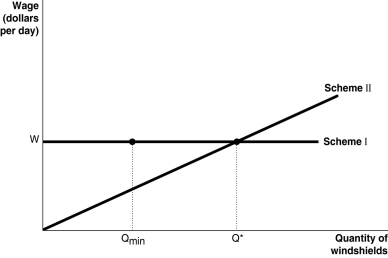Figure 17-6  Figure 17-6 shows two different compensation schemes for the Safelite Glass Corporation, an installer of auto glass windshields. Under Scheme I, the firm pays a consistent wage of $80 per day based on an 8-hour workday. Qmin represents the cut-off point under the hourly-wage system: if a worker installed fewer than Qmin windshields, the worker got fired. Scheme II represents a piece-rate scheme with an earnings floor: no worker would get less than $80 per day (for an 8-hour workday) and would have to produce at least Qmin. For any output level beyond Q* the worker earned an additional $20 for each unit produced.
Figure 17-6 shows two different compensation schemes for the Safelite Glass Corporation, an installer of auto glass windshields. Under Scheme I, the firm pays a consistent wage of $80 per day based on an 8-hour workday. Qmin represents the cut-off point under the hourly-wage system: if a worker installed fewer than Qmin windshields, the worker got fired. Scheme II represents a piece-rate scheme with an earnings floor: no worker would get less than $80 per day (for an 8-hour workday) and would have to produce at least Qmin. For any output level beyond Q* the worker earned an additional $20 for each unit produced.
-Refer to Figure 17-6. Under Scheme I,
A) workers compete with each other to see who can produce beyond Qmin in the shortest possible time.
B) workers have no incentive to produce beyond Qmin.
C) workers signal their productivity to the firm by consistently producing above Qmin.
D) the incentive to increase productivity depends on where Qmin is set; if it is at a very high level, then workers will rise to the challenge for fear of losing their jobs.
Correct Answer:
Verified
Q208: As nonunion construction workers replace a unionized
Q210: Most economists believe that only a small
Q212: While labor unions tend to negotiate above-equilibrium
Q221: The application of economic analysis to human
Q222: Figure 17-5 Q227: In the medical profession, pediatricians receive lower
![]()
Unlock this Answer For Free Now!
View this answer and more for free by performing one of the following actions

Scan the QR code to install the App and get 2 free unlocks

Unlock quizzes for free by uploading documents